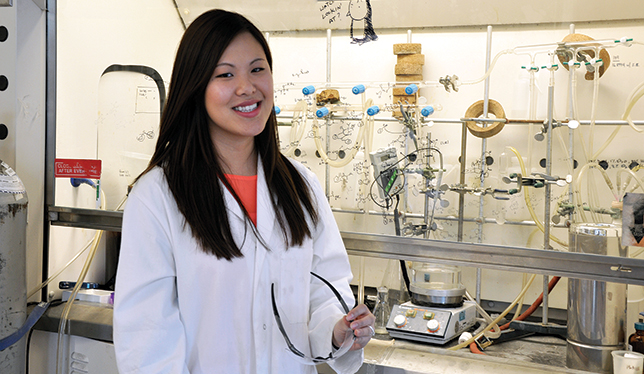When Christine Le was a kid, she became passionate about science from watching Bill Nye the Science Guy and Popular Mechanics for Kids. Add a supportive high school teacher and you end up with Ms. Le’s career today. She is nearing completion of her PhD in organic chemistry at the University of Toronto’s prestigious Lautens Research Group, but the 26-year-old’s reputation far exceeds that of most doctoral students.
In 2013, Scientific American named her one of its “30 under 30” and she was among a few dozen “best and brightest” young researchers from around the world to mingle with Nobel Prize winners at the annual Lindau Nobel Laureate Meeting in Lindau, Germany. Last January, Ms. Le was the only Canadian named to Forbes magazine’s “Top 30 under 30” – described as an influential list of “young game changers, movers and shakers” – in the science and health category. She plans to attend the Forbes’ Under 30 Summit in Philadelphia in October.
Ms. Le has been recognized for her research into catalytic reactions that speed up chemical processes, leading to more efficient and environmentally friendly methods to recreate molecules found in nature. “In the most ideal scenario,” says Ms. Le, “whatever you put into a reaction gets incorporated into your desired product. Industries are eager to adopt these kinds of “green chemistry” techniques that will reduce hazardous by-products during the manufacturing process.
She was singled out by Forbes based on her work exploring a promising route to a new anti-cancer drug. About a decade ago, researchers from Harvard University discovered a fungus growing in Costa Rica containing a molecule, cytosporone B, with potential anti-cancer properties. To make the molecule in the lab, Ms. Le used a transition metal catalyst – in this case, rhodium, a member of the platinum group often used in jewellery. “It was a 100 per cent ‘atom-economical’ reaction,” she says, “which means all the atoms we started with are used and there’s no waste at all.”
Mark Lautens, head of the research facility that bears his name, is a Killam Research Fellow, recipient of the Order of Canada and Ms. Le’s thesis advisor. “When you’re trying to find cutting-edge discoveries, you start with a good idea but most things don’t work,” he says. “So what do you do when you fail? The difference between the good student and the exceptional student is that a good student gets a result and says, ‘okay, I guess I’ll try this or that next.’ The exceptional student intuitively senses something in the results that helps them specifically design their next experiment to dramatically improve their chances of success. That describes Christine.”
Asked what she believes makes a good researcher, Ms. Le replies without hesitation: “Being well-versed in the literature, reading it on a daily basis. I always say, a day in the library will save you a week in the lab.”
The daughter of a single mother who works as a beautician, Ms. Le is the first member of her immediate family to go to university, qualifying for scholarships to help her manage it financially. At first she set her sights on medical school. “I wanted to be a doctor,” she says, “because the average teenager doesn’t know about a career called ‘organic chemist.’” But, while doing a BSc at Western University, she studied different areas of chemistry and by the time she started an MSc at U of T, she’d developed a passion for organic chemistry. Today, when not doing her research, she is a TA and private tutor.
Last year, Ms. Le was a TA for a second-year chemistry course taught by Barb Morra, who she had met when Dr. Morra was a grad student at Western. The class wasn’t mandatory and Ms. Le noticed that 100 students dwindled to as few as 15 or 20 by mid-semester. Why? Ms. Le noticed they struggled with certain areas of the course, especially the case-study question on the exam which gave the students a complex structure and asked them to design a path using the reactions they’d learned in class. But the course mainly taught students 200 or so reactions, which Ms. Le suspected most learned by rote memorization, not by understanding the basic reactivity of molecules which is necessary to doing the complex problem-solving required to apply what they’d learned in practice. With Dr. Morra on board as the faculty member, Ms. Le won a fellowship last year to develop a new tutorial approach for the course, intended to improve learning outcomes for undergrads and help them become inspired by science, as a high school chemistry teacher had inspired her.
“If you understand how to do that one complex question,” says Ms. Le, “you can do all the easy questions. So far, after one exam, I’ve noticed that the students did fantastically well on questions they used to struggle with.”
So where does she see her career in a few years? In academe, teaching and doing research (she expects to defend her thesis in August 2016 and says she has not yet thought about postdoc opportunities). While not the type to brag, she admits to a dream of leading her own research group, like her thesis advisor does.
“She’s extremely creative and has already had a big impact on her research field,” says Dr. Lautens. “She’s not a full professor at Harvard yet, but you can see that everything is on the right track.”
